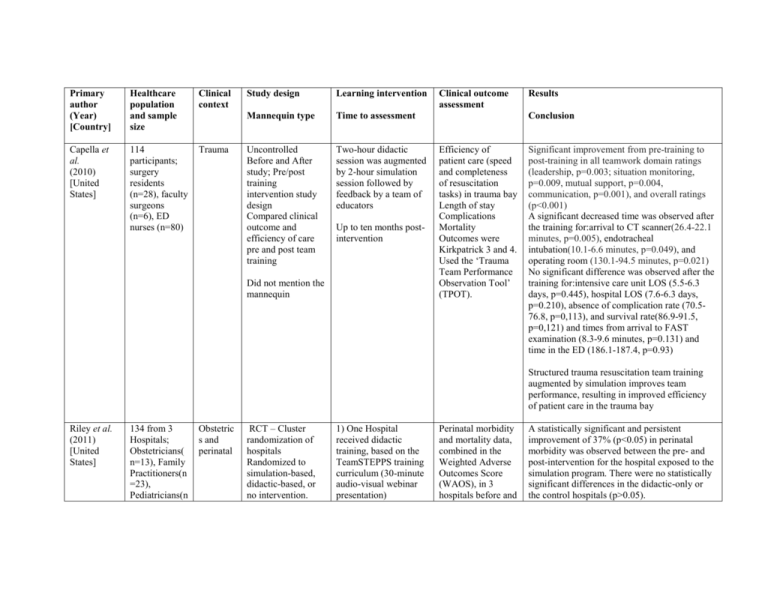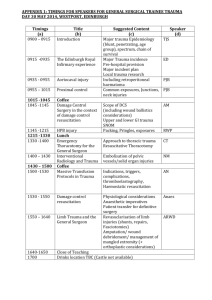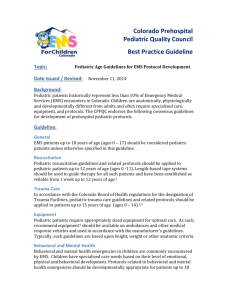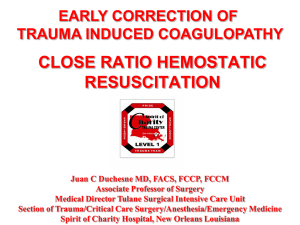12630_2014_143_MOESM2_ESM
advertisement

Primary author (Year) [Country] Healthcare population and sample size Clinical context Capella et al. (2010) [United States] 114 participants; surgery residents (n=28), faculty surgeons (n=6), ED nurses (n=80) Trauma Study design Learning intervention Mannequin type Time to assessment Uncontrolled Before and After study; Pre/post training intervention study design Compared clinical outcome and efficiency of care pre and post team training Two-hour didactic session was augmented by 2-hour simulation session followed by feedback by a team of educators Up to ten months postintervention Did not mention the mannequin Clinical outcome assessment Results Conclusion Efficiency of patient care (speed and completeness of resuscitation tasks) in trauma bay Length of stay Complications Mortality Outcomes were Kirkpatrick 3 and 4. Used the ‘Trauma Team Performance Observation Tool’ (TPOT). Significant improvement from pre-training to post-training in all teamwork domain ratings (leadership, p=0.003; situation monitoring, p=0.009, mutual support, p=0.004, communication, p=0.001), and overall ratings (p<0.001) A significant decreased time was observed after the training for:arrival to CT scanner(26.4-22.1 minutes, p=0.005), endotracheal intubation(10.1-6.6 minutes, p=0.049), and operating room (130.1-94.5 minutes, p=0.021) No significant difference was observed after the training for:intensive care unit LOS (5.5-6.3 days, p=0.445), hospital LOS (7.6-6.3 days, p=0.210), absence of complication rate (70.576.8, p=0,113), and survival rate(86.9-91.5, p=0,121) and times from arrival to FAST examination (8.3-9.6 minutes, p=0.131) and time in the ED (186.1-187.4, p=0.93) Structured trauma resuscitation team training augmented by simulation improves team performance, resulting in improved efficiency of patient care in the trauma bay Riley et al. (2011) [United States] 134 from 3 Hospitals; Obstetricians( n=13), Family Practitioners(n =23), Pediatricians(n Obstetric s and perinatal RCT – Cluster randomization of hospitals Randomized to simulation-based, didactic-based, or no intervention. 1) One Hospital received didactic training, based on the TeamSTEPPS training curriculum (30-minute audio-visual webinar presentation) Perinatal morbidity and mortality data, combined in the Weighted Adverse Outcomes Score (WAOS), in 3 hospitals before and A statistically significant and persistent improvement of 37% (p<0.05) in perinatal morbidity was observed between the pre- and post-intervention for the hospital exposed to the simulation program. There were no statistically significant differences in the didactic-only or the control hospitals (p>0.05). =14), registered nurse(n=65), certified registered nurse anesthetist(n= 18), physician assistant(n=1) Groups were compared using clinical outcome scores. Did not mention the mannequin 2) One hospital received TeamSTEPPS augmented by repeated in-situ simulation training; total 11 sessions (30 to 45 minutes each) then 2h debriefing session 3) One hospital had no intervention (Control) Up to ten months postintervention Steinemann et al. (2011) [United States] 137 team members; staff surgeons (n=9), staff ED physicians (n=21), residents (n=24), physician assistants (n=3), nurses (n=44), respiratory therapists (n=23), and technicians (n=13) Trauma Uncontrolled Before and After study; Pre/post training intervention study design compared clinical outcome pre and post team training during actual trauma resuscitations Simman® (Laerdal®) The intervention was a high-fidelity simulatorbased, in situ team training: (1) an online pretest and one-hour webbased presentation; (2) a three-hour simulation session, comprised of a 30 minute didactic plus 2½ hours of videotaping and debriefing scenarios (19 sessions with 3 scenarios in each); (3) an online post-test. Up to ten months postintervention after intervention, calculated quarterly up to 10 months after the intervention. Safety Attitudes Questionnaire (SAQ)to measure the subjective impression of the culture of safety at each hospital before and after a one year period of intervention Efficiency of patient care (the speed and completeness of resuscitation tasks) during 141 actual trauma resuscitations before the intervention and 103 after. Blood transfusion Procedures Length of stay Mortality Also measured process of care (behaviour: Kirkpatrick 3). Used the ‘NonTechnical Skills Scale for Trauma’ No significant change in the perception of culture of safety (p>0.05) at the 3 hospitals Interdisciplinary in situ simulation training is effective in decreasing perinatal morbidity and mortality for perinatal emergencies Didactics alone were not effective in improving perinatal outcomes Significant improvements in the objective parameters of speed and completeness of resuscitation: 76% increase in the frequency of near-perfect task completion (p<0.001) and reduction by 16% of mean overall ED resuscitation time (p<0.05) Significant increase in CRM performance scores from the pre-to post-training periods (TNOTECHS score 16.7 to 17.7, p<0.05). There was a 76% increase in the frequency of nearperfect task completion. The mortality rate, mean ICU and hospital LOS were not significantly different before and after the training all p>0.05) A relatively brief (4 hour) simulation-based curriculum can improve clinical performance of multidisciplinary trauma teams and patients’ outcomes Andreatta et al. (2011) [United States] Phipps et al. (2012) [United States] 228, junior and senior pediatric medicine resident with code team members: RNs, medical students, pediatric hospitalists, pharmacists) About 185 subjects(186 Pre CRM, 120 post CRM); obstetrician, perinatologist, Labor and delivery RN, certified nurse midwives, Anesthesiologi s, certified registered nurse anesthetists, Resident physician /fellow Pediatric s resuscitat ion Mixed quantitative and qualitative methodsLongitudinal cohort study for 4 years Observed patients’ outcome as the training occur over several years METI Pediatric HPS® (METI®) or SimBaby® (Laerdal®) Obstetric s and perinatal ITS Patient outcomes were assessed using data collected quarterly for 8 quarters prior to initiating the program and for the 6 quarters after implementing the program Hospital wide, multidisciplinary simulation -based CRM intervention was applied to assess clinical outcome data collected 8 quarters Participants responded to 252 pediatric resuscitations mock codes randomly, at the frequency of at least once a month in the hospital Events were recorded and used for immediate debriefing facilitated by clinical faculty to provide subjects feedback about their performance Up to several years post-intervention CRM was taught using a didactic portion lasted 4 hours, and was followed 3-7 days later by a 4-hour highfidelity medical simulation (2 scenarios) and debriefing session Up to several years post-intervention (T-NOTECHS). Hospital records for real pediatric resuscitation survival rates through the 48month study duration After the routine integration of the formal mock code program into residency curriculum, resuscitation survival rates significantly increased from 33% to 50% within 1 year, in increments that correlated with the increasing number of mock code events (r =0.87), and held steady for 3 consecutive years Simulation-based mock codes can provide a sustainable and transferable learning context for advanced clinical training and assessment that ultimately decreased mortality for pediatric resuscitations The Adverse Outcomes Index (AOI); Healthcare professionals attitude towards culture of safety using the Agency for Healthcare Research and Quality (AHRQ) Hospital Survey on Patient Safety Culture; Patient satisfaction. AOIs significantly decreased from 0.052 (95% CI:0.048-0.055) at baseline to 0.043 (95%:CI, 0.04 – 0.047). Overall, the frequency of event reporting and the overall perception of safety did not change significantly. No change in patient perception but were satisfied >90% even before the intervention Using the combination of a didactic and simulation-based CRM training was noted to improve patient outcomes pre-interruption and 6 quarters post interruption. Noel® (Gaumard®) CRM = crisis resource management; ED = emergency department; ITS = interrupted time series; MD = medical doctor; RCT = randomized controlled trial; RN = registered nurse; WAOS = weighted adverse outcomes score; LOS = length of stay.








